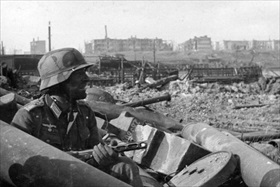SOVIETS PREPARE TO ANNIHILATE AXIS ARMIES
Stalingrad, Soviet Union · January 10, 1943
On this date in 1943 the Soviets launched Operation Ring, their name for the action that tightened the noose around the 250,000-plus soldiers of the German Sixth Army trapped in Stalingrad (now Volgograd). Operation Ring had been preceded by Operation Uranus (November 19–23, 1942), a one-million-man-plus Soviet offensive targeting the weaker Romanian and Hungarian forces that protected the Sixth Army’s flanks.
In a surprise move 2 days before, this on the evening of January 8–9, 1943, Soviet Gen. Georgi Zhukov issued Sixth Army commander Gen. Friedrich Paulus an ultimatum to surrender his troops, as well as those of his Italian, Romanian, and Hungarian auxiliaries. The ultimatum reinforced the Red Army’s stranglehold on the trapped Axis units—that all hope of a rescue was hopeless and further resistance pointless. The Soviets promised food, medicine, and guarantees of safety to Axis prisoners and repatriation after the war. Yet Adolf Hitler, in the safety of Wolf’s Lair, his perfectly camouflaged wooden barracks in the Rastenburg swamps of East Prussia (now in Poland), would have none of it and coldly sent his soldiers and officers, as well as those of his Axis partners, to their doom.
When the Soviets after 5 months of fighting finally lifted the Stalingrad siege in late January 1943, between 650,000 and 750,000 Axis soldiers and airmen had been killed or wounded, as well as 107,000 captured. (Of the prisoners taken at Stalingrad, half would die on the march to Siberian prisoner of war camps, and nearly as many would die in captivity.) Though Red Army casualties are estimated to have been well over a million (one estimate is 478,741 dead and 650,878 wounded and as many as 40,000 civilians killed), the “Great Patriotic War” had now shifted in the Soviets’ favor and the Axis powers would claim no further strategic victories in the East.
In the immediate aftermath of Stalingrad, the Red Army launched 8 winter offensives. After the “catastrophe on the Eastern Front,” Minister of Public Enlightenment and Propaganda Joseph Goebbels noted in his diary that, for the first time, premonitions of downfall and death began to spread in Hitler’s inner circle.
Battle of Stalingrad, August 23, 1942, to February 2, 1943
 |  |
Left: A massive German strategic bombing raid on August 23, 1942, caused a firestorm, killing thousands of Stalingrad residents and turning the city into a vast landscape of rubble and burned-out ruins.
![]()
Right: Carrying a Soviet submachine gun, a German soldier seeks cover among the ruins of an industrial area in Stalingrad.
 |  |
Left: A group of Soviets prepares to ward off a German assault in Stalingrad’s suburbs.
![]()
Right: Soviet soldiers crawl in the rubble of Stalingrad’s Red October Steel Factory.
 |  |
Left: Prisoners of war Field Marshal Friedrich Paulus and 2 staff members meet at the headquarters of Soviet 64th Army Chief, Lt. Gen. Vasily Chuikov, January 31, 1943. Ironically, Chuikov was in Berlin in April and May 1945, where he was the first Allied officer to hear of Adolf Hitler’s April 30th suicide. He accepted the surrender of Berlin’s garrison on May 2, 1945.
![]()
Right: German troops as prisoners of war, 1943. Out of the nearly 107,000 Axis prisoners captured in Stalingrad, only about 6,000 ever returned home after the war. Already weakened by disease, starvation, bone-chilling cold, and lack of medical care during the encirclement, they were sent on death marches (75,000 survivors died within 3 months of capture) to prisoner camps and later to labor camps all over the Soviet Union. Some 35,000 were eventually sent on transports, of which 17,000 did not survive. Most died of wounds, disease (particularly typhus), cold, overwork, mistreatment, and malnutrition.
Soviet Newsreel of Field Marshal Paulus and Senior German Officers After Their Capture, Late January–Early February 1943. Stalingrad Survivors March Into Captivity
![]()

 History buffs, there is good news! The Daily Chronicles of World War II is now available as an ebook for $4.99 on Amazon.com. Containing a year’s worth of dated entries from this website, the ebook brings the story of this tumultuous era to life in a compelling, authoritative, and succinct manner. Featuring inventive navigation aids, the ebook enables readers to instantly move forward or backward by month and date to different dated entries. Simple and elegant! Click
History buffs, there is good news! The Daily Chronicles of World War II is now available as an ebook for $4.99 on Amazon.com. Containing a year’s worth of dated entries from this website, the ebook brings the story of this tumultuous era to life in a compelling, authoritative, and succinct manner. Featuring inventive navigation aids, the ebook enables readers to instantly move forward or backward by month and date to different dated entries. Simple and elegant! Click 











